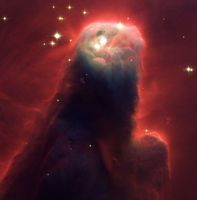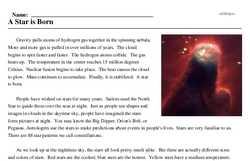A Star is Born
Gravity pulls atoms of hydrogen gas together in the spinning nebula. More and more gas is pulled in over millions of years. The cloud begins to spin faster and faster. The hydrogen atoms collide. The gas heats up. The temperature in the center reaches 15 million degrees Celsius. Nuclear fusion begins to take place. The heat causes the cloud to glow. Mass continues to accumulate. Finally, it is stabilized. A star is born.
People have wished on stars for many years. Sailors used the North Star to guide them over the seas at night. Just as people see shapes and images in clouds in the daytime sky, people have imagined the stars form pictures at night. You may know the Big Dipper, Orion's Belt, or Pegasus. Astrologers use the stars to make predictions about events in people's lives. Stars are very familiar to us. There are 88 star patterns we call constellations.
As we look up at the nighttime sky, the stars all look pretty much alike. But there are actually different sizes and colors of stars. Red stars are the coolest; blue stars are the hottest. Yellow stars have a medium temperature. Think of the colors of the flames of a bonfire. The top of the flame is red; it has the least heat. The middle of the flame is yellow. The bottom of the flame, where there is the most heat, is blue. Like a flame, you can tell how hot a star is from its color.
Dwarf stars are very common. Their sizes range from half the size of our Sun to one hundred times smaller than our Sun. The red dwarf is the most common star in the galaxy. However, they are not easily seen. They burn their fuel very slowly and are not as bright as others in the sky. They are like flashlights in a dark auditorium. When a big spotlight comes on, the flashlights can't be seen. But because they burn more slowly, red dwarfs will live a long time, maybe trillions of years!
Our Sun is a medium yellow star. It has a medium size and temperature. Yellow stars burn fuel more quickly than red ones. They are also brighter. They are like the spotlights in the dark auditorium.




